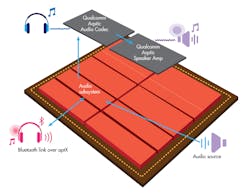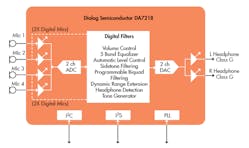With the increasing adoption of smartphones and tablets, the demand for audio codecs also is growing. To satisfy the high standards of audiophiles, audio ICs are also evolving in terms of their level of sophistication and quality. The demand for a high-quality audio experience with smartphones is rising as mobile users use their phones not only to talk or text but to listen to music or play other multimedia content. Simply put, users want to have a better audio experience and if they are into music, they want the best possible audio experience.
This trend is pushing audio-codec designers to build audio solutions that will improve wired and wireless audio experiences while using consumer electronic such as phones, headphones, virtual reality headsets, etc. Power consumption keeps being one of the challenges at the time of decoding signals and including more functionality into programmable DSPs can be challenging but beneficial because they can adapt an audio codec to perform new functions or adapt audio codecs to be used in new applications or even comply with emerging standards.
System integration, for example, is becoming more common in the audio codec market. For example, Qualcomm Technologies recently integrated Qualcomm Aqstic technology into the Qualcomm Snapdragon 835 processor. The Qualcomm Aqstic WCD9341 audio codec (Fig. 1) has an integrated digital-to-analog converter (DAC) that supports up to 192-kHz/24-bit playback. As is typical, the performance of this new audio codec is measured in terms of signal-to-noise ratio (SNR) and total harmonic distortion + N (THD + N). With an SNR at 115 db, it can also support dual oscillators. The dual-clock design supports sampling frequencies of 44.1 kHz and 48 kHz, independently.
Snapdragon processors audio architecture is designed to optimize both wired and wireless audio. (Courtesy of Qualcomm)
In applications such as audio accessories, wired headsets, and wired headphones, there are several options in the audio codec market. A number of high-performance, low-power audio codecs can support the always-on audio detect function now present in many consumer audio devices. Dialog Semiconductor, for instance, offers the DA7218, a high-performance low-power audio codec optimized for use in portable applications or wearable devices.
The DA7218 has the ability to run the ADCs at a different sample rate to the DACs. (Courtesy of Dialog Semiconductor)
In a 32-ball WLCSP with 0.5 mm pitch, the DA7218 contains stereo audio analog to digital converters (ADCs) that can run either in low-power mode for always-on applications or in high-performance mode for other applications, improving power consumption. It features voice mode filtering up to 32 kHz with a high-performance stereo-DAC-to-headphone playback path with 100 dB SNR.
Cirrus Logic (the company that supplies audio chips used in iPhones) offers the CS47L15, a smart codec with low power consumption that enables OEMs to cost-effectively incorporate advanced audio features. Examples include “always on” voice activation, enhanced karaoke, and virtual stereo and protection algorithms for emerging enhanced speaker playback.
The CS47L15 supports SPI and I2C interface modes for control-register access. (Courtesy of Cirrus Logic)
The device has an integrated multichannel 24-bit, hi-fi audio hub codec with 98-dB signal-to-noise ratio (SNR) mic input (48 kHz) and 127-dB SNR headphone playback (48 kHz). The CS47L15 provides battery life savings by maximixing the battery life in voice, music, and standby modes. The power, clocking, and output driver architectures are designed to .ow-power (25 µW). Sleep Mode is supported, with configurable wake-up events. An additional supply is required for the Class D speaker drivers (typically direct connection to 4.2-V battery).
Audio codec manufacturers are taking new challenges by enhancing the audio experience of the new multimedia trends: wireless headphones, phones, virtual reality. There is no doubt that audio codecs are elevating the audio experience for mobile users and with the data speeds benefits of the upcoming 5G network the quality of audio will only get better.




